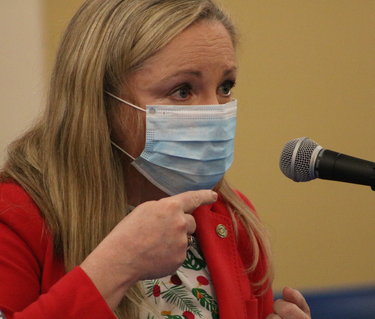CDC expands list of symptoms for COVID-19
The Enterprise — Michael Koff
The top part of a surgical mask has a piece of aluminum under the fabric, at the center; this should be pinched to fit snugly over the bridge of your nose. “Pinch it to get a good seal over your nose,” said Health Commissioner Elizabeth Whalen, explaining this gives better infection control and also won’t fog eyeglasses.
ALBANY COUNTY — In the midst of the pandemic, Albany County is particularly concerned about its “vulnerable populations,” said Health Commissioner Elizabeth Whalen and last weekend did an extensive investigation of “cases and contacts.”
Since about 80 percent of people infected with COVID-19 have a “mild illness,” Whalen said, it is “so important” for essential workers to note the first signs of illness in themselves, to get tested, and to stay home from work immediately.
On Sunday, the Centers for Disease Control and Prevention expanded its list of symptoms for coronavirus disease 2019. “It’s not just fever; it’s not just a cough; and it’s not just shortness of breath, or difficulty of breathing,” Whalen stressed.
Other symptoms can include chills, repeated shaking, muscle pain, a headache, a sore throat, or a new loss of taste or smell.
“These may be early signs of COVID-19 infection,” said Whalen.
Obviously, Whalen said, headaches are common and a lot of people are currently suffering from tension and stress headaches. “It’s important to know yourself,” said Whalen. People working with vulnerable populations should be aware of “anything outside the realm of how you normally feel,” she said.
People who work with the public, particularly with vulnerable populations, such as in nursing homes, need to “stop working and get tested” if they have any of these symptoms, Whalen said. Once you are tested, Whalen stressed, “Do not go back to work.” Rather, she said, “Go home until you have your result.”
She said such employees should return to work only after getting negative test results and only after the initial symptoms have left.
Nursing homes should have temperature and symptom checks daily, she said.
“We need the workers themselves to be more educated and more vigilant about these minor symptoms,” she said.
Whalen concluded, “Before the pandemic, you would say, ‘I’ll just tough it out and see how I feel.’ We do not want people to tough it out … This is how the disease is being spread.”
If you have symptoms, Whalen urged, “Speak to your doctor. Speak to us in the health department — and get tested.”
How to don and doff a mask
At the county’s press briefing on Monday morning, Whalen gave a demonstration on how to wear a surgical mask. She had said earlier that masks are worn primarily to prevent spreading disease to others — source control — rather than to protect the wearer.
You should wash or sanitize your hands before putting on a mask. The colored side faces out while the white side goes against your face.
You should hold a mask just by the elastic loops on either side of the mask, and loop one string over each ear, making sure both the nose and mouth are covered.
The top part of a mask has a piece of aluminum under the fabric, at the center; this should be pinched to fit snugly over the bridge of your nose. “Pinch it to get a good seal over your nose,” said Whalen, explaining this gives better infection control and also won’t fog eyeglasses.
The mask should be removed by, again, touching just the ear loops and not the mask itself.
If you plan to re-use a mask, you shouldn’t leave it on a surface that could contaminate it. If the mask is dirty or wet, it can’t be used again.
A video on the county’s website demonstrates the proper way to use a surgical mask.



